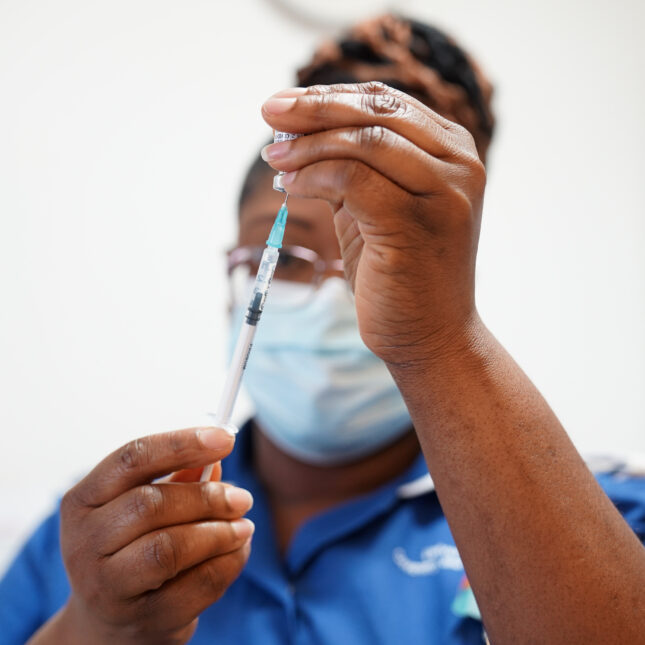
The Centers for Disease Control and Prevention said Wednesday it’s too early to tell whether a new version of the SARS-CoV-2 virus that has triggered some international concern will actually prove to be disruptive.
In a preliminary statement about the BA.2.86 subvariant, the CDC also revealed that updated Covid-19 vaccines should be available across the country as early as mid-September, earlier than previous estimates have placed the start of the fall booster campaign.
The vaccines, made by Pfizer, Moderna, and Novavax, must first be authorized by the Food and Drug Administration, and recommended by the CDC’s expert vaccine panel, the Advisory Committee on Immunization Practices, and the CDC itself. The three manufacturers have said they have doses at the ready for when the FDA and CDC sign-offs come.
The new subvariant, BA.2.86, contains a large number of mutations — as many as were seen in the initial version of Omicron when it was compared to the Delta variant viruses it replaced. That large number of changes allowed Omicron viruses, which emerged in late 2021, to more effectively transmit by escaping the immunity many people had built up to that point. That led to a massive wave of infections and reinfections late 2021 and into 2022.
But whether this new subvariant, which has now been found in Denmark, South Africa, Israel, the United States, and the United Kingdom, will be anywhere near as disruptive as Omicron remains to be seen. To date there’s no indication it triggers more severe illness, the agency said, adding that scientists are studying whether the updated vaccines that will soon be available will protect effectively against BA.2.86. They target the XBB.1.5 version of the virus.
“CDC’s current assessment is that this updated vaccine will be effective at reducing severe disease and hospitalization,” the CDC statement said. “At this point, there is no evidence that this variant is causing more severe illness. That assessment may change as additional scientific data are developed.”
Covid cases in this country and elsewhere have been on the rise in recent weeks. But the CDC said that transmission increase is most likely not due to BA.2.86; its start predated the appearance of the new subvariant.
That said, it is currently difficult to assess how widespread the new subvariant is. Countries around the world have cut back dramatically on Covid sequencing efforts, meaning authorities trying to gauge the potential impact of BA.2.86 have a fraction of the genetic data that were regularly shared in the pandemic.
“We have poor surveillance globally. We have declining sequencing globally. … We’re getting slower. And this is to our detriment,” Maria Van Kerkhove, the World Health Organization’s team lead for Covid-19, bemoaned about the state of global Covid monitoring in a recent interview with STAT. That interview predated the spotting of BA.2.86.
The CDC statement said it appears that existing Covid tests are able to detect the new subvariant, and that the antiviral drugs Paxlovid, Veklury, and Lagevrio will be effective against it. With such a significant number of mutations, it is possible that the new version will be able to evade some of the immunity that has been built up through vaccination, infection and a combination of the two, the agency said.
“The large number of mutations in this variant raises concerns of greater escape from existing immunity from vaccines and previous infections compared with other recent variants,” the CDC statement said. “However, virus samples are not yet broadly available for more reliable laboratory testing of antibodies, and it is too soon to know the real-world impacts on immunity.”
Scientists warned about jumping to conclusions about BA.2.86 at this point.
“Intrinsic severity of a virus is a byproduct of many traits, a product of selection on other features. Any attempt to guess the intrinsic severity of BA.2.86 (within reasonable parameters) is just that — a guess,” Aris Katzourakis, an evolutionary biologist at the University of Oxford, wrote on the social media site Mastodon. “It is far, far too early to evaluate the potential of this variant. And it is a timely reminder of the role of evolution in the ongoing pandemic.”
Michael Osterholm, director of the University of Minnesota’s Center for Infectious Disease Research and Policy, said his view about new subvariants is that they must be watched closely, but we should resist the urge to catastrophize. “I assume that all are innocent until proven guilty,” he said, noting that a number of variants and subvariants that initially seemed alarming have not taken off globally.










Exciting news! STAT has moved its comment section to our subscriber-only app, STAT+ Connect. Subscribe to STAT+ today to join the conversation or join us on Twitter, Facebook, LinkedIn, and Threads. Let's stay connected!
To submit a correction request, please visit our Contact Us page.